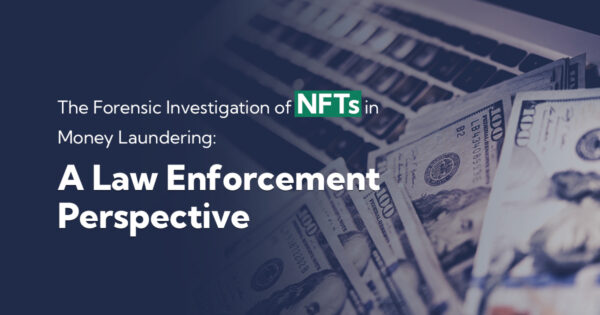Introduction
As the popularity of non-fungible tokens (NFTs) continues to grow, so too does their potential for being exploited in money laundering schemes. Consequently, law enforcement agencies are working on developing methods to forensically investigate NFTs involved in illicit activities. In this section of the blog post, we will explore some of the techniques and tools used by law enforcement to trace and analyze NFT transactions connected to money laundering.

1. Blockchain Analysis
NFTs are built on blockchain technology, which provides a public ledger of all transactions. Law enforcement can use this information to analyze and trace the flow of funds through NFT transactions. Several tools and software, such as Chainalysis, Elliptic, and CipherTrace, are designed to help investigators track and visualize blockchain transactions, identify patterns, and reveal connections between wallet addresses.
2. De-anonymizing Wallet Addresses
While NFT transactions are pseudonymous, law enforcement can employ various techniques to de-anonymize wallet addresses and link them to real-world identities. For example, investigators can use off-chain data, such as social media profiles, email addresses, or IP addresses, to establish connections between individuals and their wallet addresses.
3. Collaboration with NFT Marketplaces and Platforms
Law enforcement agencies often work with NFT marketplaces and platforms to obtain user information, transaction records, and IP addresses. These platforms can provide valuable information that helps investigators identify the parties involved in suspicious transactions, especially if they have implemented know-your-customer (KYC) and anti-money laundering (AML) procedures.
4. Financial Forensics
Financial forensics plays a crucial role in tracing the flow of illicit funds through NFT transactions. By examining the financial records of suspects, law enforcement can identify discrepancies or unusual patterns in their financial activities, which may indicate money laundering.
5. Cryptocurrency Exchange Cooperation
Cryptocurrency exchanges are often the point where illicit funds are converted back into fiat currency. Law enforcement agencies can collaborate with these exchanges to obtain transaction records, user information, and wallet addresses, which can help link NFT transactions to real-world identities and uncover money laundering schemes.
6. International Cooperation and Information Sharing
Money laundering involving NFTs often transcends national borders, making international cooperation and information sharing essential. Law enforcement agencies can work together through organizations such as Interpol, Europol, and the Financial Action Task Force (FATF) to share intelligence, best practices, and coordinate efforts in combating the misuse of NFTs for money laundering.
7. Machine Learning and Artificial Intelligence
Advanced analytical tools, such as machine learning and artificial intelligence, can help law enforcement identify patterns and anomalies in NFT transactions that may indicate money laundering. These tools can process large volumes of data and automatically flag suspicious transactions, making it easier for investigators to focus on high-risk cases.
Conclusion
Law enforcement agencies are continually adapting their investigative techniques to address the evolving landscape of financial crime, including the use of NFTs in money laundering. By leveraging blockchain analysis, financial forensics, international cooperation, and advanced analytical tools, they can effectively track, identify, and prosecute those exploiting NFTs for illicit purposes. As the NFT market continues to grow, it is essential for law enforcement, regulators, and the industry to work together to ensure that this innovative technology is not abused by criminals. But the simple truth is tracking illicit money flows through NFTs is very hard to do.


